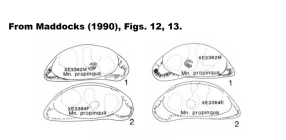
| Intro | | About | | Wiki | | Search traits | | Data explorer | | Literature | | Definitions | | Sources | | Webservices | | Statistics | | Feedback | | Editors | | Log in |
WoRMS taxon detailsMacrocyprina propinqua Triebel, 1960
460304 (urn:lsid:marinespecies.org:taxname:460304)
accepted
Species
marine,
recent only
Triebel, E. (1960). Die taxionomische Stellung und die Gattungen der Unterfamilie Macrocypridinae (Ostracoda). <em>Senckenbergiana Biologica.</em> 41, 109-124. [details]
Holotype SMF Xe 3361, geounit Bonaire part of the...
Holotype SMF Xe 3361, geounit Bonaire part of the Caribbean Sea [details]
Etymology "Name: From propinquus, related; because of the resemblance to Macrocypris maculata (BRADY 1866)." free translation from...
Etymology "Name: From propinquus, related; because of the resemblance to Macrocypris maculata (BRADY 1866)." free translation from theGerman to English. [details] Stratigraphy Holocene
Stratigraphy Holocene [details]
Brandão, S. N.; Antonietto, L. S.; Pereira, J. S.; Pereira, S. G. G.; Sá, H. A. B.; Praxedes, R. A.; Sabater, L. M., Santos, S.G.; Karanovic, I. (2025). World Ostracoda Database. Macrocyprina propinqua Triebel, 1960. Accessed through: World Register of Marine Species at: https://www.marinespecies.org/aphia.php?p=taxdetails&id=460304 on 2025-05-21
Date action by
Nomenclatureoriginal description
Triebel, E. (1960). Die taxionomische Stellung und die Gattungen der Unterfamilie Macrocypridinae (Ostracoda). <em>Senckenbergiana Biologica.</em> 41, 109-124. [details] Otheradditional source
Maddocks, R. F. (1990). Living and fossil Macrocyprididae (Ostracoda). <em>University of Kansas Paleontological Contributions Monograph.</em> No 2: 1-285. [details]
 Present Present  Present in aphia/obis/gbif/idigbio Present in aphia/obis/gbif/idigbio  Inaccurate Inaccurate  Introduced: alien Introduced: alien  Containing type locality Containing type locality
Holotype SMF Xe 3361, geounit Bonaire part of the Caribbean Sea [details]
From editor or global species database
Diagnosis "Diagnosis.—Carapace very small, ovate-oblong in lateral view; dorsal margin broadly and gently arched; anterior margin broadly rounded and slightly truncate; ventral margin with rather shallow ventral indentation, not up-swung posteriorly, broadly rounded posterior angle of about 50º; zone of concrescence broad, vestibules correspondingly restricted.Male fifth limbs very asymmetrical; right limb with sinuate podomere II, just one elongate peg, one very long dorsal seta, and a short, right-angled, tapering distal hook recurved at 85'; left limb with slender podomere II, one acutely pointed peg, a long dorsal seta, and a tiny, nearly straight, acutely pointed distal hook curved at 158°. Female fifth limb slender with slender terminal claws. Sixth limb with dorsodistal claw nearly as long as mediodistal claw. Recurved seta of seventh limb with very tiny hairs and spatulate distal tip. Furcae long, slender, gracefully tapering, curved, with small proximal setae. Hemipenis crescent-shaped, with straight dorsal margin, obliquely arcuate, convex ventral margin, and bluntly rounded anterodorsal margin, and with additional lobate anterodorsal accessory lamella; copulatory rod short, straight. Zenker's organ with small terminal bulb; vas deferens ar- ranged in three loose loops as long as the Zenker's organ." (Maddocks, 1990: 110) [details] Diagnosis "Carapace very small, ovate-oblong in lateral view; dorsal margin broadly and gently arched; anterior margin broadly rounded and slightly truncate; ventral margin with rather shallow ventral indentation, not up-swung posteriorly, broadly rounded posterior angle of about 50º; zone of concrescence broad, vestibules correspondingly restricted. Male fifth limbs very asymmetrical; right limb with sinuate podomere II, just one elongate peg, one very long dorsal seta, and a short, right-angled, tapering distal hook recurved at 85'; left limb with slender podomere II, one acutely pointed peg, a long dorsal seta, and a tiny, nearly straight, acutely pointed distal hook curved at 158°. Fe- male fifth limb slender with slender terminal claws. Sixth limb with dorsodistal claw nearly as long as mediodistal claw. Recurved seta of seventh limb with very tiny hairs and spatulate distal tip. Furcae long, slender, gracefully tapering, curved, with small proximal setae. Hemipenis crescent-shaped, with straight dorsal margin, obliquely arcuate, convex ventral margin, and bluntly rounded anterodorsal margin, and with additional lobate anterodorsal accessory lamella; copulatory rod short, straight. Zenker's organ with small terminal bulb; vas deferens arranged in three loose loops as long as the Zenker's organ." (Maddocks, 1990: 110) [details] Dimensions "Paratype male NMFIS Xe 3362, RVL 1.00 mm, RVI I 0.44 mm. Paratype female NMFIS Xe 3364, RVI. 1.05 mm, RVH 0.47 mm." (Maddocks, 1990: 109) [details] Dimensions Length: female 1,02-1,08mm, male 0,95-1,00mm. (Triebel, 1960) [details] Etymology "Name: From propinquus, related; because of the resemblance to Macrocypris maculata (BRADY 1866)." free translation from theGerman to English. [details] Stratigraphy Holocene [details] |


